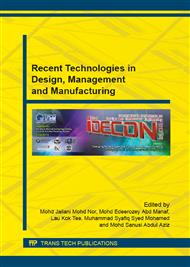[1]
X. Peng, M. Fan, J. Hartley, M. Al-Zubaidy, Properties of natural fiber composites made by pultrusion process, J. Compos. Mater. 46 (2011) 237-246.
DOI: 10.1177/0021998311410474
Google Scholar
[2]
A. Carlsson, B.T. Astrom, Modeling of heat transfer and crystallization kinetics in thermoplastic composites manufacturing: Pultrusion, Polym. Compos. 79 (1998) 352-359.
DOI: 10.1002/pc.10108
Google Scholar
[3]
R.M.L. Coeldo, V.M.A. Calado, An optimization procedure for the pultrusion process based on a finite element formulation, Polym. Compos. 23 (2002) 329-341.
DOI: 10.1002/pc.10435
Google Scholar
[4]
Y.C. Lam, J. Li, C.S. Joshi, Simultaneous optimization of die-heating and pull-speed in pultrusion of thermosetting composites, Polym. Compos. 24 (2003) 199-209.
DOI: 10.1002/pc.10020
Google Scholar
[5]
B.T. Astrom, Development and application of a process model for thermoplastic pultrusion, Compos. Manuf. 3 (1992) 189-197.
Google Scholar
[6]
S.U.K. Gadam, J.A. Roux, T.A. McCarty, J. Voughan, The impact of the pultrusion processing parameter on resin pressure rise inside a tapered cylinder die for glass-fibre epoxy composite, Compos. Sci. Technol. 60 (2000) 945-958.
DOI: 10.1016/s0266-3538(99)00181-5
Google Scholar
[7]
S. Li, L. Xu, Z. Ding, L.J. Lee, H. Engelen, Experimental and theoretical analysis of pulling force in pultrusion and resin injection pultrusion (RIP)-Part I: Experimental, J. Compos. Mater. 37 (2003) 163-189.
DOI: 10.1106/002199803028676
Google Scholar
[8]
E. Lackey, J.G. Vaughan, An analysis of factors affecting pull force for the pultrusion of graphite/epoxy composites, J. Reinf. Plast. Compos. 13 (1994) 188-198.
DOI: 10.1177/073168449401300301
Google Scholar
[9]
R. Senawi, Pultrusion Procedure (Innovative Pultrusion Sdn Bhd), Senawang, (2012).
Google Scholar
[10]
W. Conshohocken, Standard test method for apparent horizontal shear strength of pultruded reinforced plastic rods by the short-beam method 1, in: ASTM Stand. 1997, pp.3-5.
DOI: 10.1520/d4475-02
Google Scholar
[11]
F. Bassam, P. York, R.C. Rowe, R.J. Roberts, Young's modulus of powders used as pharmaceutical, Pharmaceutics. 64 (1990) 55-60.
DOI: 10.1016/0378-5173(90)90178-7
Google Scholar
[12]
K.H. Kim, J.L. Ong, O. Okuno, The effect of filler loading and morphology on the mechanical properties of contemporary composites, Prosthet. Dent. 87 (1992) 642-649.
DOI: 10.1067/mpr.2002.125179
Google Scholar
[13]
M. Bhattacharya, A.K. Bhowmick, Polymer–filler interaction in nanocomposites: New interface area function to investigate swelling behavior and Young's modulus, Polym. 49 (2008) 4808-4818.
DOI: 10.1016/j.polymer.2008.09.002
Google Scholar


